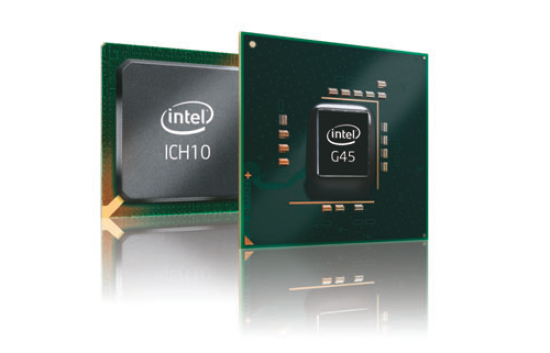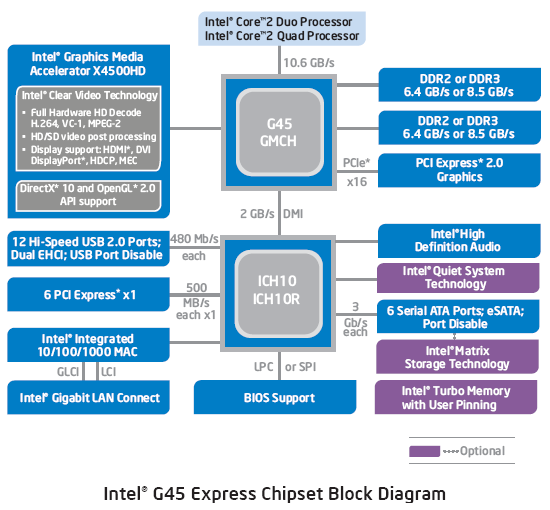Intel Launches Low-Power 65nm 4 Series Chipsets for the Desktop
by Kris Boughton on June 5, 2008 12:00 AM EST- Posted in
- CPUs
Intel Corporation has chosen the opening day of the 28th annual Computex trade show – the international electronics and technology information event held once a year in Taipei, Taiwan – to launch their next-generation 4 Series Express chipset family for mainstream desktop PCs. Consisting of the Intel P45, G45, P43, and G43 Express Chipsets, these new 4-series chipsets bring advancement in capabilities intended to satisfy even the most demanding gamers, power users, and HD video and audio aficionados alike. Among other advancements, Intel 4 Series Express chipsets (with the exception of X48), along with new 45nm dual- and quad-core CPUs scheduled for launch in the second half of 2008, will also introduce support for new low-power states intended to usher in a new era of energy efficient computing.
The 4-series chipset line will be manufactured exclusively using Intel's time-tested 65nm process technology, marking the first time Intel's PCI-E and memory core logic circuits have been scaled below 90nm. Nehalem, Intel's first CPU microarchitecture to incorporate an on-die integrated memory controller (IMC), will take this one step further by shrinking the transistor body length in these circuits down to just 45nm. Given the enormous costs associated with any manufacturing process change and the devastating implications an early failure would have on Intel's public confidence level, its no wonder they are being extreme cautious about this move. Anyone that needs any more convincing on this matter need only see what's happened to AMD as a results of their decision to be more aggressive than Intel in their quest for the production of the world's first "true" quad-core CPU. Indeed, it makes far more sense for Intel to test out just how well their current memory controller design works at 65nm before they go for the coup de grâce with the shrink to 45nm.

As far as graphics go, G45 is expected to be G35 on steroids; don't expect any big differences between this generation of chipsets and last.
With the Intel PR bunnies officially hard at work in Taiwan gushing forth the merits of this new line of chipsets, we would expect to see products from the usual manufactures appearing on retail shelves any day now. We brought you an early, first-hand look at some of the more measurable P45 performance figures last month when we spotlighted the ASUS P5Q3 Deluxe, but since then we have not had any other motherboard vendors come forward with product for review. If there was any truth to the rumor that Intel re-spun the P45 silicon one last time (the fabled A3 revision) in order to address a particularly nasty PCI-E graphics bug, then that would certainly explain the apparent lack of boards. It takes time to get freshly-made chipsets to Tier-1 partners and it's easy to miss product launches with the availability of actual product when trying to deal with last minute delays.
Each of the new Intel 4 Series chipsets supports a maximum validated front side bus (FSB) speed of 1333MT/s (333MHz) and dual-channel DDR3 memory technology up to 1066MHz. We've seen this before, and in fact this main-bus-to-memory-bus configuration reminds us of the Intel Mobile PM/GM965 chipset and its support for 800MHz FSB processors and a maximum memory speed of just DDR2-667. Given this, it's not too hard to imagine these 4-series chipsets were created with the intention of being the first real, viable replacements for notebook OEMs looking to use something other than aging PM/GM965 chipsets with their now-outdated GMA X3100 integrated GPUs. The mere mention of chipset low-power states should be enough to justify this conclusion. We didn't say it before but we'll say it now: the new 45nm CPUs expected to appear later this year will almost certainly be of the low-power mobile type.

If you look at it in the right light the G45-based platform block diagram looks like any other.
When you put it all together – the same-day public introduction of the 45nm Intel Atom CPU (with integrated GMA 500 graphics), the 4 Series Express chipsets' power-saving manufacturing process change to 65nm (down from 90nm), the rumored late-2008 availability of low-power dynamically-adjustable 45nm Core2 (mobile) CPUs, and Intel's almost frantic need to address NVIDIA's Tegra GPUs for ultra-mobile devices as well as their new 780a-based platform with Hybrid-SLI technology – it's not hard to see why these chipsets needed to launch right now. Intel desperately needs an extremely flexible, HD-capable GPU if they plan on staying competitive with NVIDIA, and they hope the GMA X4500HD will be just that. Whether or not this ends up the case remains to be seen, but as the lines separating traditional PC technologies and consumer electronics devices continue to blur, Intel and NVIDIA are all but guaranteed to become increasingly competitive on this front.
Of course, if we are right, the corollary to all of this is rather disappointing news for overclockers and performance enthusiasts. In that case, the 4 Series Express chipset launch cannot be seen as anything other than a move by Intel to gain a much larger share of the embedded-GPU device market. Low-cost, low-power, and high-performance are rarely seen in the same sentence together and knowing this we really can't fault Intel for not giving us a chipset that smashes the already exceptional X48 performance figures out of the park. Except for a few highly-specialized rouge benchmarks, don't expect a P45-based system to outpace any X48 board worth its salt, at least not by any significant margin. For those that choose a P45 board over a comparably equipped X48 board, the most you can really hope for is a small costs savings, probably on the order of $40 to $60.
Let's finish up our look at these new 4 Series chipsets by examining a few of the features and improvements closer. Those that are looking to build their next High Definition Home Theater PC (HTPC) might just see something worth investigating.










14 Comments
View All Comments
SunAngel - Saturday, June 14, 2008 - link
So, from what I read, I can by a G45 board, throw in a Celeron 440 (2.0GHz, 800FSB, Single-core) and run 1080p 50/60 HDTV and Blu-ray with no problems what-so-ever. If true, this is great for the pocket-book. $150 for a DG45ID board, $55 for a Celeron 440, $35 for a 1GB DDR2-800, $40 for a 80GB HDD, $170 for Blu-ray/HD-DVD drive, $75 for a nice, tiny, mATX case, and $150 for two ATSC TV tuner cards. More than fair pricing for a Media Center PC.burfi - Thursday, June 5, 2008 - link
I was very much interested in pairing an E7200 with the DG45FC "Fly Creek" Mini-ITX, until I learned about the 24W TDP for the G45/G43 from Intel's documents. Now I'm in doubt, as I consider that rather excessive and hard to cool in that form-factor. Price below 150$ or 100€ is attractive though.And yes, this article indeed reads like slightly massaged Intel marketing material.
strmbkr - Thursday, June 5, 2008 - link
I agree.24W? Doesn't AMD's 780G chipset consumes only 10W (or was that the 790G?)? and in idle only 0.95W?
"AMD claims idle power consumption of the IGP is just 0.95W!"
http://www.firingsquad.com/hardware/amd_780g_overc...">http://www.firingsquad.com/hardware/amd_780g_overc...
Intel is Apple's Padawan now me thinks.
Karlzbad - Thursday, June 5, 2008 - link
So when are we going to see these babies in stores in the US? Nobody seems to know anything about them.ilkhan - Thursday, June 5, 2008 - link
Could you answer, in the first or second paragraph, this simple question?"Whats the difference between the P45 and the P43?" Since I presume that the G43 and G45 and just the P4x version + graphics. So, whats the difference?
kjboughton - Thursday, June 5, 2008 - link
P45 does 1x16 and 2x8 PCI-E lane configurations whereas P43 only does 1x16. G45 and G43 are like P43: 1x16 only, here though they are differentiated by the integrated GPU "type" (more like G43 has had some HD features locked). G45 is GMA X4500HD and G43 is GMA X4500. According to Intel each handles hardware-accelerated Bru-ray content so to tell you the truth the differences in the capabilities of the GPUs is still somewhat unknown.ilkhan - Thursday, June 5, 2008 - link
Reading through again (with P45 highlighted, all 7-8 occurances) the only difference I see is that the P45 can be set for 2x8 PCI-E lanes. Great, except the G45 cant do that, so its not the difference. Humbug.Visual - Thursday, June 5, 2008 - link
I am anxious to see the integrated graphics performance in comparison to the latest AMD and nVidia chipsets.I hope AOpen will release a new version of their MiniPC with this new chipset soon. Will make a great gift for my dad.
formulav8 - Thursday, June 5, 2008 - link
Intel is supposely claiming near AMD Chipset video performance. They had along ways to go to get their trash up to that high of speed. So I would bet they are simply using 3DMark 06 as a indication, but in actual games its still pathetic.But you never know I quess. I would be somewhat shocked if it did rival AMDs.
Last I heard Intel didn't even have DX10 drivers yet?
Jason
CSMR - Thursday, June 5, 2008 - link
Good news article with some new information. Nehalem is 45nm? Fast progress, one chipset die shrink after another.